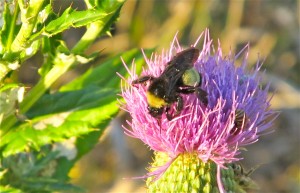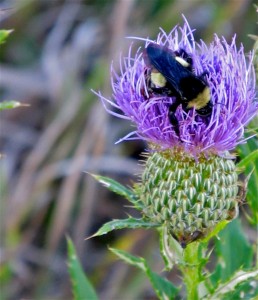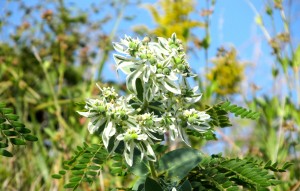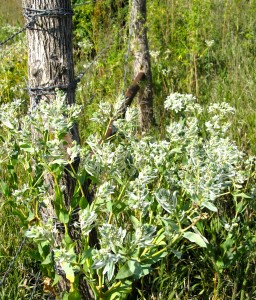By Elby Adamson

Bumble Bee on Thistle

Bumble Bee on Thistle
In late summer and early fall nature’s pallet in Kansas contains the beauty of purple thistles, yellow sunflowers and a plant commonly called snow-on-the-mountain.
Dry conditions over much of the state in early summer have suppressed this last plants growth this year but it is still showy in spots filling waste areas, roadside ditches and over-grazed pastures with drifts of white. While this weed may be beautiful, Snow-on-the-mountain is masquerading. It can be dangerous and some authorities say it can be deadly to cattle if consumed in large quantities dried in hay.

Snow on the Mountain
Technically, this plant isEuphorbia marginata and it is a relative of the poinsettias that are popular potted plants at Christmas time. Like the poinsettia, the beauty of Snow-on-the-mountain is not from its undersized flowers, but rather from the bracts, the modified leaves that surround the flowers.

Snow on the Mountain
Bracts are specialized leaves that surround the flowers and in the case of both Snow-on-the-mountain and poinsettias may through bright, colorful appearance attract pollinating insects to the flowers.
As with many members of the Euphorbia family including spurges and the poinsettia, Snow-on-the –mountain contains a milky sap that can cause an allergic reaction much like that of poison ivy in some people. The sap is said to be especially irritating to mucous membranes and the eyes.
Yet, in some parts of the eastern U.S., the plant is grown as an ornamental in spite of its less desirable qualities.
It should not be confused with another plant, Bishop’s weed or Goutweed that is sometimes also called Snow-on-the-mountain. That plant– Aegopodium podagraria ‘Variegatum’– is a member of the Parsley family and is often used as a ground cover especially in shady areas.
In Kansas Snow-on-the-mountain is usually considered a nuisance plant and when it is in pastures, cattle won’t eat it because of a bitter taste and the irritation from the sap. Farmers and ranchers often spray it with herbicides to control its tendency to spread profusely.
Snow-on-the-mountain flourishes in sun and tolerates heat and dry conditions very well, but caution should be taken if you rashly pick it for a wildflower bouquet or decide to plant it as an ornamental in the flowerbed.
All photos by the author




